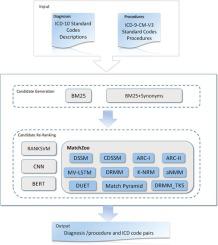当前位置:
X-MOL 学术
›
J. Biomed. Inform.
›
论文详情
Our official English website, www.x-mol.net, welcomes your feedback! (Note: you will need to create a separate account there.)
A study of entity-linking methods for normalizing Chinese diagnosis and procedure terms to ICD codes.
Journal of Biomedical informatics ( IF 4.5 ) Pub Date : 2020-04-13 , DOI: 10.1016/j.jbi.2020.103418 Qiong Wang 1 , Zongcheng Ji 2 , Jingqi Wang 2 , Stephen Wu 2 , Weiyan Lin 3 , Wenzhen Li 3 , Li Ke 3 , Guohong Xiao 3 , Qing Jiang 4 , Hua Xu 2 , Yi Zhou 5
Journal of Biomedical informatics ( IF 4.5 ) Pub Date : 2020-04-13 , DOI: 10.1016/j.jbi.2020.103418 Qiong Wang 1 , Zongcheng Ji 2 , Jingqi Wang 2 , Stephen Wu 2 , Weiyan Lin 3 , Wenzhen Li 3 , Li Ke 3 , Guohong Xiao 3 , Qing Jiang 4 , Hua Xu 2 , Yi Zhou 5
Affiliation

|
OBJECTIVE
This study aims to develop and evaluate effective methods that can normalize diagnosis and procedure terms written by physicians to standard concepts in International Classification of Diseases(ICD) in Chinese, with the goal to facilitate automated medical coding in China.
METHODS
We applied the entity-linking framework to normalize Chinese diagnosis and procedure terms, which consists of two steps - candidate concept generation and candidate concept ranking. For candidate concept generation, we implemented both the traditional BM25 algorithm and an extended version that integrates a synonym knowledgebase. For candidate concept ranking, we investigated a number of different algorithms: (1) the BM25 algorithm, (2) ranking support vector machines (RankSVM), (3) a previously reported Convolutional Neural Network (CNN) approach, (4) 11 deep ranking-based methods from the MatchZoo toolkit, and (5) a new BERT (Bidirectional Encoder Representations from Transformers) based ranking method. Using two manually annotated datasets (8,547 diagnoses and 8,282 procedures) collected from a Tier 3A hospital in China, we evaluated above methods and reported their performance (i.e., accuracy) at different cutoffs.
RESULTS
The coverage of candidate concept generation was greatly improved after integrating the synonym knowledgebase, achieving 97.9% for diagnoses and 93.4% for procedures respectively. Overall the new BERT-based ranking method achieved the best performance on both diagnosis and procedure normalization, with the best accuracy of 92.1% for diagnosis and 80.1% for procedure, when the top one concept and exact match criteria were used.
CONCLUSIONS
This study developed and compared diverse entity-linking methods to normalize clinical terms in Chinese and our evaluation shows good performance on mapping disease terms to ICD codes, demonstrating the feasibility of automated encoding of clinical terms in Chinese.
更新日期:2020-04-21



























 京公网安备 11010802027423号
京公网安备 11010802027423号